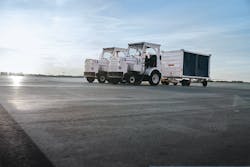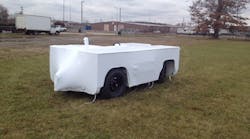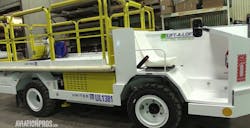As the airline industry was impacted by the coronavirus pandemic, the number of flights was drastically reduced as demand dipped. As a result, less ground support equipment (GSE) was needed on the ramp.
Ground service providers began putting GSE into long-term storage this spring, and in some cases may still be storing equipment for an extended period of time.
The timetable for airlines’ return to pre-pandemic traffic levels is uncertain. But as people return to the skies and flight traffic increases, ground handlers and GSE maintenance personnel will need to take steps to safely return equipment to service.
There is no one-size-fits-all solution when it comes to storing GSE, explains Leigh Hoey, GSE manager for WestJet and Encore.
“It is greatly dependent on geographic location and the individual situation for each company involved,” Hoey says, adding IATA has published guidelines for storing GSE. “Storage method is influenced by environmental factors, fleet size, degree of business downturn, GSE maintenance staffing levels, space available for parking and anticipated length of time before equipment is required again.”
Hoey also notes that as an alternative to storing, ground service personnel may rotate units in and out of operation where possible to minimize the amount of time one unit sits and to reduce the work involved in setting units up for storage.
When opting to store GSE, Kevin Cecil, engineering manager – loaders at JBT, notes most units will have storage instructions in the manual. For JBT equipment, the company covers two types of storage – one month and indefinite.
“Generally, you will want to service the engine; disconnect the battery; chock drive wheels; retract all cylinders where possible; and do any other corrosion prevention that can be done,” he says. “If you have the ability to keep the units out of the elements – such as rain, snow, sand, heat, cold – this will also help. But it is not available for many.”
“At minimum, units must have stabilizer added to prevent fuel degradation, which can lead to operational issues and costly repairs when equipment is slated to return to operation,” Hoey adds. “If possible, units should also be started and moved to prevent tires from getting flat spots.”
Overall, Mark DiMaria, technical support manager at Textron GSE, notes the typical preparation process consists of a number of best practices focused on the lubrication system, hydraulic system, fuel system, cooling system, air/vent/exhaust, battery, transmission and tires, among others.
If these practices are not followed, GSE can be damaged and acidic fluids may corrode parts of the unit.
“So, when you go to start them up, it causes some premature wear and takes lifecycle away from some of the major components,” DiMaria says.
He also recommends ensuring the cab is empty before storing and taking steps to prevent rodents and insects from nesting in or around the out-of-service equipment.
Back to Business
JBT’s Cecil points out a plan to return equipment to service will be influenced by a number of factors. To determine the number of pieces of GSE needed, an operation should review current conditions; determine the amount of preventative maintenance (PM) required; and establish budgets and timelines.
When it comes to operational and safety checks, Cecil says it is always best to follow the manual for a specific piece of equipment.
“Operationally, you will need to check fluids, lubrication, tire inflation and such,” Cecil says. “From a safety standpoint, you will need to look for leaks, make sure the brakes and emergency stops all work and let’s not forget about environmental gremlins like wasps that can sting, rodents that can eat wires or birds building nests.”
Textron GSE’s DiMaria explains ground service providers must calculate what equipment is required based on flight volume, duration between flights, aircraft models, gate locations and turnaround needs. Once that amount of equipment is determined, most of the process is simply reversing the measures taken at the time of storage.
“Most of your initial steps are really doing a good visual of everything, so you can see if anything has happened while it’s in long-term storage,” he says.
“You just want to make sure you go through 100 percent of the functions, get the equipment up to operating temperature and then come back and do a good, thorough visual inspection on it to make sure you don’t have any leaks.”
WestJet’s Hoey says companies should review and create their own plans based on reversing the specific steps taken by their operation to store the GSE.
“One key factor to consider as equipment is reinstated is to review GSE maintenance staffing levels to ensure enough resources are in place to perform necessary safety checks and repairs,” he says.
Ideally maintenance schedules should continue during storage periods to preserve the assets, Hoey explains. But he notes that in reality, schedules may have been halted to save money.
“If a maintenance schedule was halted on any equipment, the units must be thoroughly inspected and serviced prior to returning to operation,” he says. “Each organization will need to assess their own situation and determine the best course with priority being to ensure the safety of each unit.”
“If equipment was only parked and didn’t go through the prep for long-term storage, then full preventative maintenance should be conducted before putting the unit back into service,” advises DiMaria. “Review the equipment manual and follow the guidelines for your specific equipment.
“If preparation for long-term storage was followed, it is not necessary to service them during the storage period,” he adds. “Once returned to service, the normal service schedule should be followed for your equipment.”
The amount of time needed to return a GSE unit to service, varies widely, Hoey explains. The type of equipment, steps taken to store it and maintenance requirements all factor in.
“The more complicated the unit, like a deicer, will increase the checks. Whereas something less complicated, like a bag tug, may take less time,” Cecil agrees. “Depending on how you stored it and if you had been following PM cycles will also determine this.”
Prepare Personnel
As flight volumes increase and equipment is returned to service, more ground handling agents will also return to the ramp. Certifications may have lapsed while GSE was out of service or while personnel were away from the job.
“It is always best practice to retrain employees, so that they are ready to safely operate once GSE is ready. Textron GSE offers a full suite of training materials, that can be used to support maintenance activities, including return to service procedures,” DiMaria of Textron GSE says.
“Each organization needs to review and determine what is required based on their own policies, along with local and federal regulations,” WestJet’s Hoey adds.
A company’s policy regarding current training may be focused on technical aspects of the equipment or safety requirements, JBT’s Cecil says.
“At JBT, we want anyone operating or maintaining equipment to be properly trained,” he notes. “To that extent, we offer onsite – at JBT – and digital training platforms to assist.”
Some airlines may be able to anticipate their operating schedule and provide recurring training to employees prior to equipment returning to service, adds DiMaria.
Cecil believes the process of returning equipment to service and retraining employees will be different for everyone, so proper planning takes on increased importance.
“Setting up a plan to evaluate the fleet you have, the units you will need, work to be done and then setting a path forward is what is needed,” he says.







